九年级英语第十三单元教案
- 格式:docx
- 大小:39.92 KB
- 文档页数:19
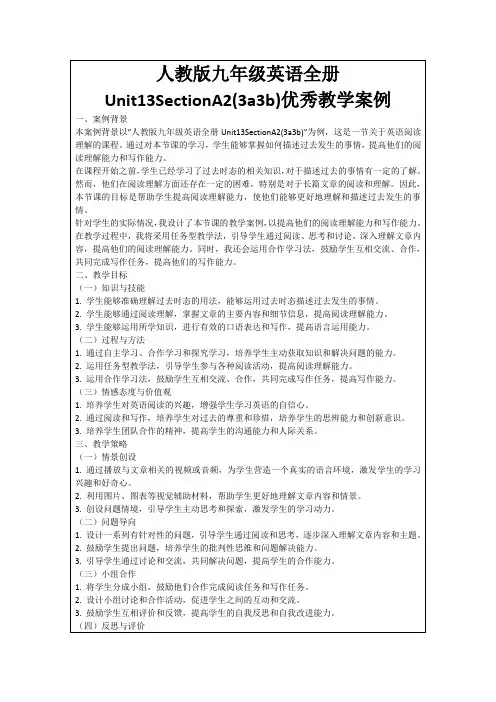
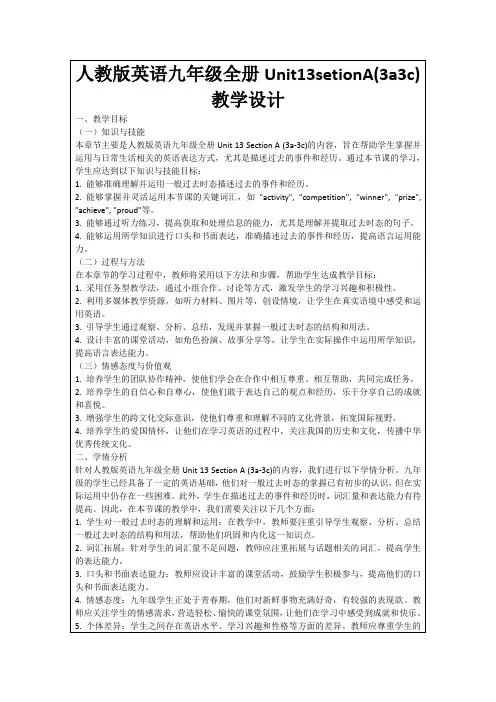
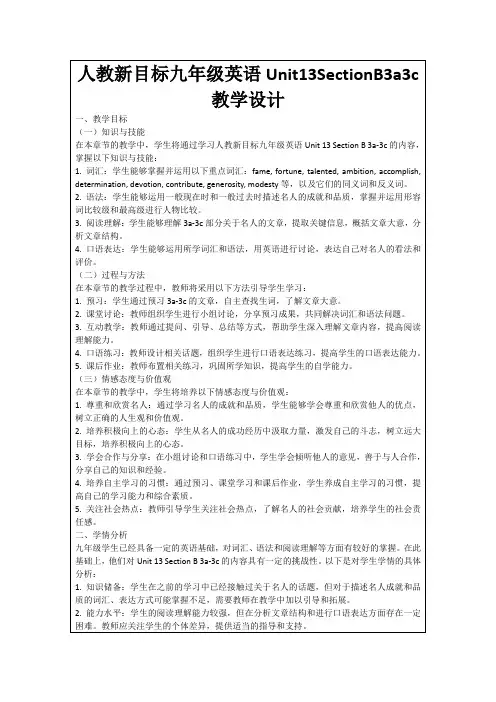
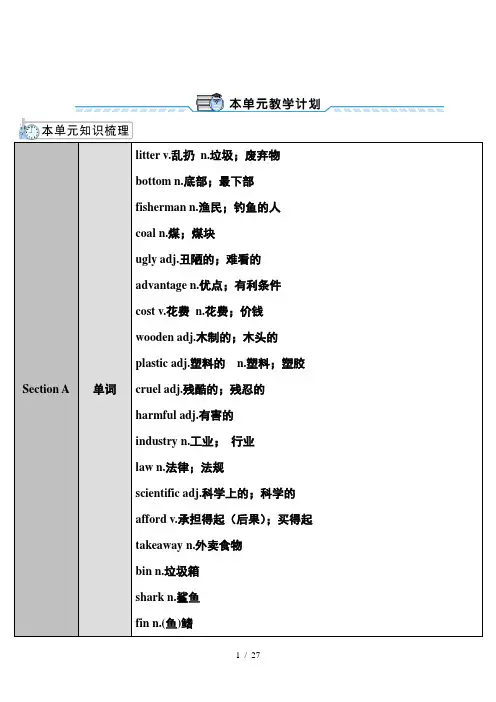
Section A 单词litter v.乱扔n.垃圾;废弃物bottom n.底部;最下部fisherman n.渔民;钓鱼的人coal n.煤;煤块ugly adj.丑陋的;难看的advantage n.优点;有利条件cost v.花费n.花费;价钱wooden adj.木制的;木头的plastic adj.塑料的n.塑料;塑胶cruel adj.残酷的;残忍的harmful adj.有害的industry n.工业;行业law n.法律;法规scientific adj.科学上的;科学的afford v.承担得起(后果);买得起takeaway n.外卖食物bin n.垃圾箱shark n.鲨鱼fin n.(鱼)鳍复习现在进行时、现在完成时和被动语态等的用法。
以“保护环境”为主题,运用本课相关句型与他人展开讨论;能向大家介绍有哪几种污染类型,怎样回收利用废弃物品等。
体会到保护环境的重要性,学会保护大自然、保护地球,从身边的小事做起,号召大家参与到保护环境的行动中来。
【课时建议】本单元建议5课时Section A (1a~2d)……………………………………………………………………………………1课时Section A (3a~4c)……………………………………………………………………………………1课时Section B (1a~1e)……………………………………………………………………………………1课时Section B (2a~2e)……………………………………………………………………………………1课时Section B (3a~3b)……………………………………………………………………………………1课时词汇短语:主要采用多媒体及图片展示法。
基本句子:采用图片展示及交际法(利用多媒体展示两人进行交际时的情景)。
语法:复习现在进行时、现在完成时和被动语态——采用“巧记歌诀”记忆法。
被动语态的用法谁的动作不知道,说出谁做没必要;承受之人需强调,被动语态莫忘了。
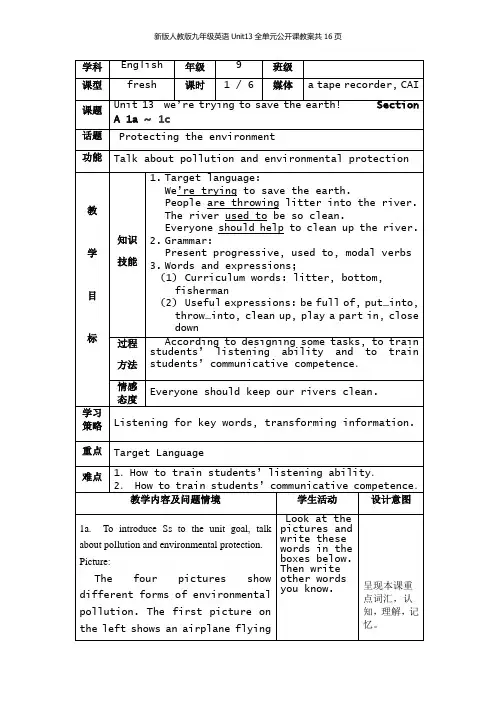
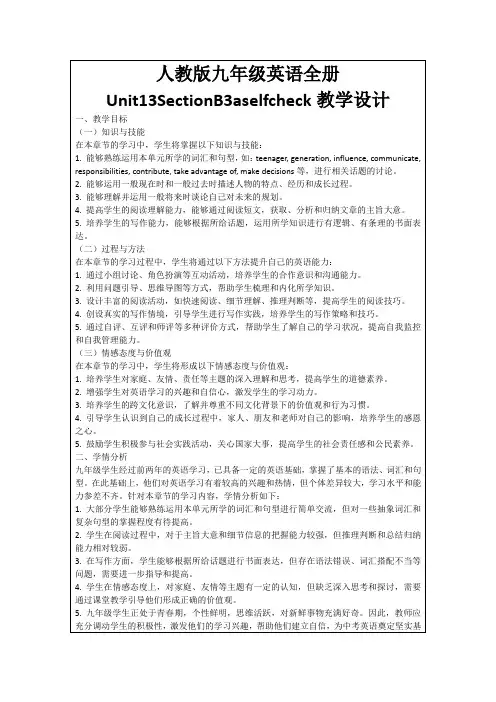
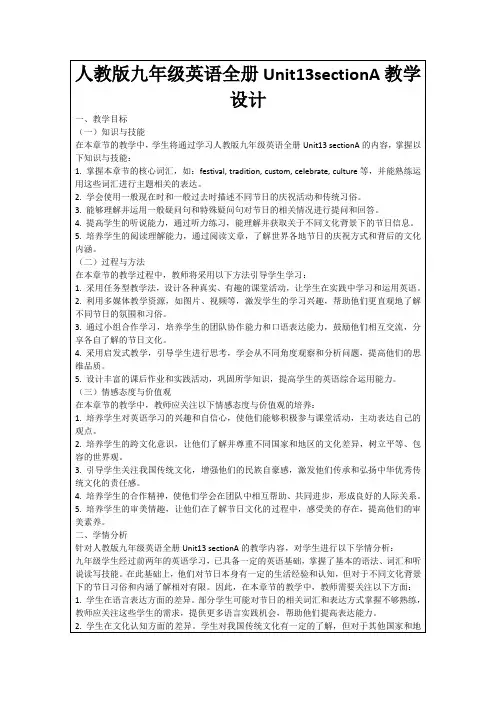
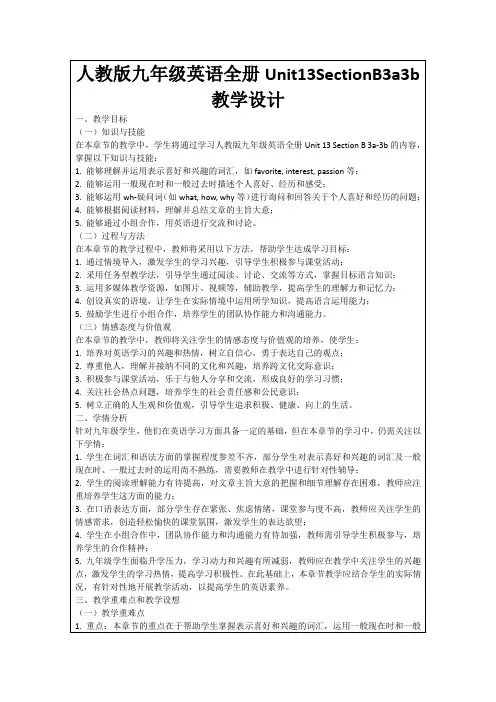
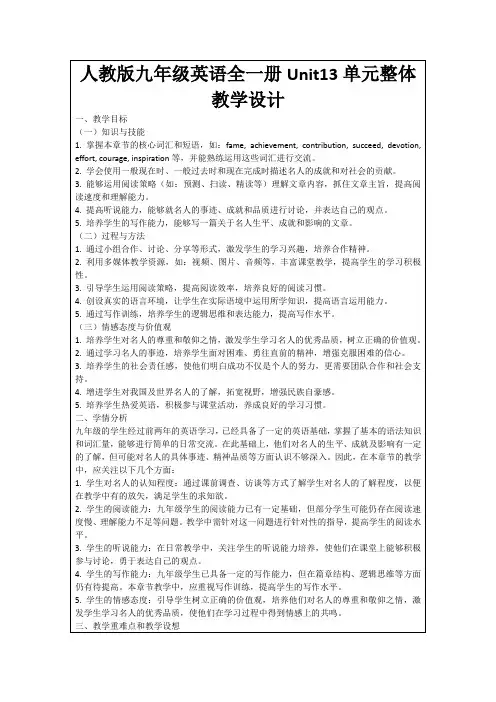
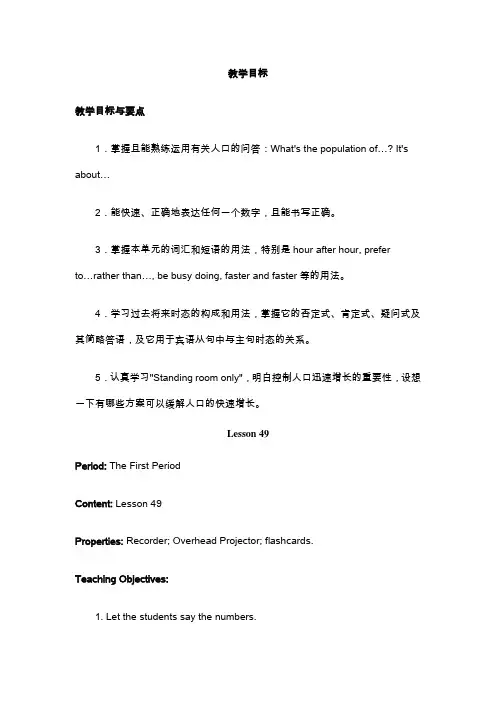
教学目标教学目标与要点1.掌握且能熟练运用有关人口的问答:What's the population of…? It's about…2.能快速、正确地表达任何一个数字,且能书写正确。
3.掌握本单元的词汇和短语的用法,特别是hour after hour, prefer to…rather than…, be busy doing, faster and faster等的用法。
4.学习过去将来时态的构成和用法,掌握它的否定式、肯定式、疑问式及其简略答语,及它用于宾语从句中与主句时态的关系。
5.认真学习"Standing room only",明白控制人口迅速增长的重要性,设想一下有哪些方案可以缓解人口的快速增长。
Lesson 49Period: The First PeriodContent: Lesson 49Properties: Recorder; Overhead Projector; flashcards.Teaching Objectives:1. Let the students say the numbers.2. Learn some new words and useful expressions.Language focus:population, million, billion, increase, grow, What’s the population of Germany?Teaching Procedures:I. Showing tile teaching aimsII. RevisionRevise the numbers between 1 and 100.III. PresentationUse flashcards or numbers on the blackboard to revise one hundred, present a thousand in the same way. Then present ten thousand/ a hundred thousand/ a million and a billionGive the students plenty of practice in reading these numbers. Point out the differences between English and Chinese for 10 000 and 100 000.IV. DrillPart 1. Play the tape for the students to listen and repeat. Show numbers on the blackboard, to give the students more practice in saying the numbers. V. PresentationPresent more difficult numbers, then go through the model. Point out how commas are used. Let the students try to say the numbers in this exercise. Hay the tape for the students to listen and repeat.VI. PracticePart 3, using a map of the world, go through contents of the table. Learn the meaning of population.For example:1. Our city has a population of two billion.2. What’s the population of Tianjin?3. China has the largest population of the world.Ask the students some questions, using the model give n, e.g.: What’s the population of…? What about the population of…? Finally, get the students to ask and answer in pairs.VII. Exercises in classLet the students do enough practice in reading the numbers.Have a dictation.1. What’s the population o f France? About fifty - eight million.2. The worlds population was about 5 300 million in 1990.3. Nine billion, eight hundred and seventy - three million, four hundred and twenty - five thousand, two hundred and sixty - one.Work in groupsShow a picture of the numbers of World’s population. Teacher speak out the names of country or city, and ask the students speak out each number one by one in their group. And then ask the other group to practise this again. Whose sound is correct and clearly? Whose number reading is best?VIII. Homework1. Revise the numbers2. Make five partners in asking the population.Lesson 50Period: The Second PeriodContent: Lesson 50Properties: Recorder; Overhead Projector; Pictures.Teaching Objectives:1. Understand the text.2. Learn some useful words and phrases.Language Focus: room, hour after hour.Teaching Procedures:I. Showing the teaching aimsII. RevisionGet the students to revise the numbers first, then give them a dictation:A. 173B. 6854C. 17 000D.456789E.88990F.378565214. Finally check their answers.III. Leading inAsk: Do you know what the population of China or any other country in the world is? Then say: Today we're going to read about the world’s population. The world’s population is growing very fast. It is a big and serious problem. Can you tell me the reasons? Let the students discuss and help them answer with: “There isn't enough food, work for too many people. There aren't enough houses…” etc.Let the students read the questions at the top of the page, get them to know very clearly, then ask them to read the passage quickly. And answer the questions.IV. ReadingGet the students to look at the Exercise below:1. How many babies are born in one hour?2. What do you think is the greatest challenge of the world today?3. How is the world’s population growing?4. When was the population over 6 billion?5. What will happen in about 600 years?Go through the questions, then read the passage more carefully, try to find all the answers in the reading. Discuss the answers with the classmates. The students should understand the meaning of the words such as: earth, mouth, space and century from the context. Let them note the use of comparative of adjectives and adverbs in the passage. Finally check the answers with the whole class.V. PracticeLet the students know a little more knowledge about the world’s population.The world’s population is now over 60 billion. It's likely to reach 10 billion by the middle of the 21st century. The Third World population is rising rapidly,straining health and education systems, hitting the environment, causing explosive urban growth and complicating food supply. So population has become a serious problem. The reading passage in this lesson aims to draw the student -concern about this great world problem.VI. Language FocusGet the students to know how to use the following word and expressions.1. room: I’m afraid, there is no room ( space ) for us on the bus.This big bag takes up too much room.Let me make room for our teacher.2. hour after hour: The clock goes on striking hour after hour.Peter stayed in bed day after day.Year after year went by, she still didn't receive her son's news.VII. WorkbookDo Exercises 2 and 3 individually, then check the answers with the whole class.The answers to Exercise 2: about, not, Multiply by. Hour after hour, fast, developing, problem, developed, slow down.The answers to Exercise 3: 1. hardly 2. at the beginning of 3. path 4. worth 5. Beg your pardonVIII. ConsolidationGo through the passage again. Discuss the problems that the population explosion will bring. Get the students to use as much English as possible.Exercises in classWrite a short passage about the population,1. 人口问题是世界上最大的问题之一。
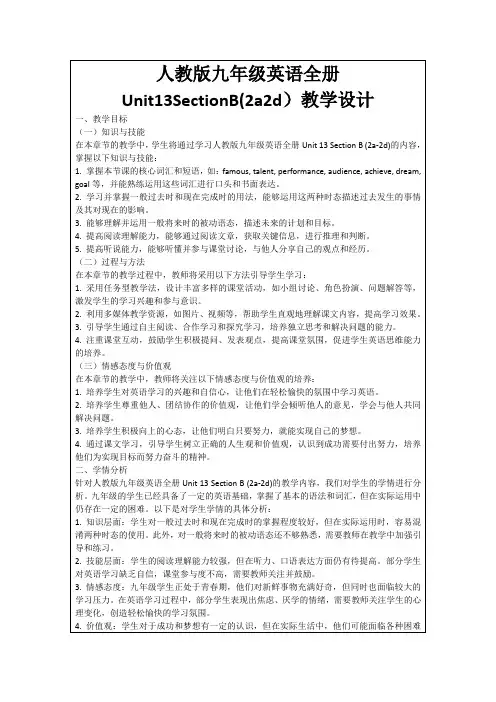
Unit 13 We’re trying to save the earth!Dajin Middle School : Wu Jingxia一、教学目标:1. 语言知识目标基本词汇:litter, advantage, bottom, fisherman, coal, ugly, cost, wooden, plastic, takeaway, bin, shark, fin, method, cruel. Harmful, chain, ecosystem, industry, law,scientific, afford, reusable, transportation, recycle, napkin, upside, gate, bottle,president, inspiration, iron, work, metal, creativity,基本词组:be harmful to, at the top(of sth.), take part in, turn off, take action, throw away, put sth. to good use, pull… down, bring back基本句型:We’re trying to save the earth!The river used to be so clean.The air is badly polluted.No scientific studies have showed that shark fins are good for health.We should help save the sharks.2. 技能目标: 能正确运用现在进行时,现在完成时,被动语态,情态动词和used to 句型。
3. 情感目标:有环境危机意识,学会关注环境保护环境。
二、教学重难点:1. 教学重点:(1)能正确运用现在进行时,现在完成时,被动语态,情态动词和usedto 句型。
Unit 13 We’re trying to save the earth!一、教学目标:二、1. 语言知识目标基本词汇:litter, advantage, bottom, fisherman, coal, ugly, cost, wooden, plastic,takeaway, bin, shark, fin, method, cruel. Harmful, chain, ecosystem, industry, law, scientific, afford, reusable, transportation, recycle, napkin, upside, gate, bottle, president, inspiration, iron, work, metal, creativity,基本词组:be harmful to, at the top(of sth.), take part in, turn off, take action, throwaway, put sth. to good use, pull… down, bring back基本句型:We’re trying to save the earth! The river used to be so clean.The air is badly polluted.No scientific studies have showed that shark fins are good for health.We should help save the sharks.2. 技能目标: 能正确运用现在进行时,现在完成时,被动语态,情态动词和usedto 句型。
3.情感目标: 有环境危机意识,学会关注环境保护环境。
三、教学重难点:1. 教学重点:(1)能正确运用现在进行时,现在完成时,被动语态,情态动词和used to 句型。
(2)保护环境的措施方法。
2. 教学难点:能正确运用现在进行时,现在完成时,被动语态,情态动词和used to 句型。
课时安排:Period1:SectionA(1a—1c) Period2: SectionA(2a—2d)Period3: SectionA(3a—3b) Period4: SectionA(Grammar focus—4c)Period5:SectionB(1a—1e) Period6: SectionB(2a—2b) Period7:SectionB(2c—2e) Period8: SectionB(3a—self-check)Unit 13 We’re trying to save the earth!Period1:SectionA(1a—1c)一、教学目标:1. 语言知识目标基本词汇:litter, advantage, bottom, fisherman, 基本词组:be harmful to, at the top(of sth.), 基本句型:We’re trying to save the earth!The river used to be so clean. The air is badly polluted.No scientific studies have showed that shark fins are good for health.We should help save the sharks.2. 技能目标: 能正确运用现在进行时,现在完成时,被动语态,情态动词和used to 句型。
3. 情感目标: 有环境危机意识,学会关注环境保护环境。
二、教学重难点:1. 教学重点:(1)能正确运用现在进行时,现在完成时,被动语态,情态动词和used to 句型。
(2)保护环境的措施方法。
2. 教学难点:能正确运用现在进行时,现在完成时,被动语态,情态动词和used to 句型。
三、教学步骤:I. PresentationShow the picture of the earth and tell students the earth is polluted now.For example:(1) The factories that burn coal pollute the air with a lot of black smoke.(2) Factories put waste into the river.(3) People should throw away litter in the bin.(4)There are more cars on the road.Learn some new words.II. Work on 1aHere are some words related to different kinds of pollution. Write them in the boxbelow. Then add more words.loud music cars rubbish planes littering ships factories smoking building houses mobile phones noise pollution air pollution water pollution ____________ ___________ _____________ _______________________ _____________ ____________ ___________ _________________________ ___________ _____________III. Listening1. Work on1b. Listen and complete the sentences. What was the problem? The river was _____________. Even the bottom (底部) of the river was full of ________. There were no more ______ for fishermen (渔民) to catch. What caused the problem? People are throwing _______ into the river. Factories are putting ______ into the river. How should the problem be solved? We should write to the ____________ and ask them to ___________ the factories. Everyone should help to __________ the river.2. Listen again and answer the following questions.1) What does Tony want to do later this afternoon?He wants to go swimming with Mark in the river later this afternoon.2) Why doesn’t Mark want to go with Tony?Because the river was really dirty. Even the bottom of the river was full of rubbish, and there were no more fish for fishermen to catch.3) How was the river in the past?It used to be so clean. It has been the nicest river in this town. IV. Practice1. Role-play the conversation in 1c.Mark: The river was dirty. Even the bottom of the river was full of rubbish. Tony: But it used to be so clean!Mark: Yes, but people are throwing litter into the river. Tony: Everyone in this town should play a part in cleaning it up! 2. Make conversations using the pollution in 1a.A: The river has always been the nicest river in this town. B: Yes, it used to be so clean.A: But I was there last weekend and the river was really dirty. B: What caused the problem?A: People are throwing litter into the river. B: What should we do?A: Factories are also putting waste into the river. B: Yes, everyone in this town should play a part.A: We should write to the government and ask them to close down the factories. B: What else can we do?A: Everyone should help to clean up the river. V. Language points1. We’re trying to save the earth! 我们正在竭尽全力拯救地球! try to do =try one’s best to do 努力去做某事。
e.g. We’ll try to finish the work in a week. 我们将努力在一周内完成这项工作。
2. Here are some words related to different kinds of pollution. be related to 与…有关e.g.Is the driver relate to the accident? 司机和这起事故有关吗?3. .Even the bottom of the river was full of rubbish.Yes, but people are throwing litter into the river. litter 和 rubbish 都可指“垃圾”,用作不可数名词。